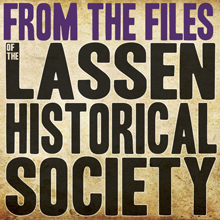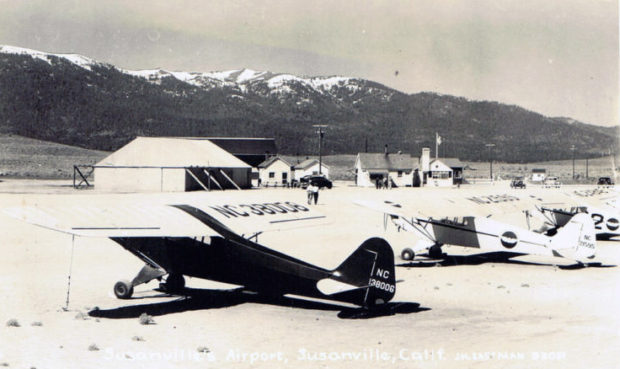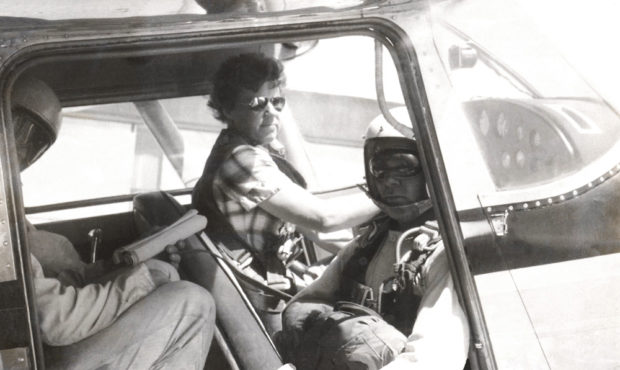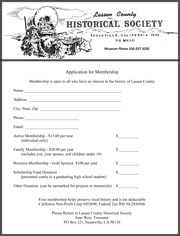

by Susan Couso
By the 1920’s American women had been a part of tremendous change – the right to vote, transformations in fashion, new advances in communication and the media and labor-saving devices on the ‘home front’ allowed women to seek new pastimes, thoughts and ideas.
This new era brought a fascination with possibilities, and women became a bigger part of the work force and the political arena. They also became enamored with the idea that women could achieve anything.
Mary Alice Utterback was born in New Jersey in 1925, but she grew up in Oberlin, Ohio, where both of her parents were teachers. She embraced this new modern age with open arms, and her early years were surrounded with news stories of the feats of Charles Lindbergh, Amelia Earhart and other daring pilots who attempted to master the skies, and this made an impression on the youthful Mary.
As with most young girls of the day, Mary’s parents had plans for her future. These plans did not include flying an airplane, but Mary had other ideas. She had a music scholarship to help with her college expenses, but that was not what she wanted to do. She wanted to fly. Mary recalled that her parents thought that she was ‘daffy.’
As the U.S. entered WWII, Mary yearned to join the Woman’s Army Corp, but she was too young. Instead, in 1945 she dropped out of Oberlin College and got a job working in a factory and other ‘odd jobs’ so that she could make money to learn how to fly. But it wasn’t that easy. Flying schools, at that time, simply did not allow women.
Without the aid of a flying school, Mary had no choice but to learn on her own, using books to learn the basics. She recalled flying with one hand while holding a book in the other, and used her wages from her factory job to rent a little Piper Cub. By 1946 she could be seen soaring over Ohio.
After the end of the war, Mary moved to New York and worked in an airplane factory, while also attending an airplane mechanics school, working to repair the planes. Here, she learned much valuable information about the planes themselves and how they functioned.
In her ‘spare time’ she flew around Brooklyn from a little field in Flushing Meadows.
Mary continued to learn and was soon certified as a flight instructor, even training commercial pilots.
About 1947 or so, Mary went to see her aunt in Lewiston, Idaho and decided to visit the airport there. She told the manager that she was a flight instructor, and he said, “Well, you’re just the person we want. We’re starting our Veteran’s Training Program.”
The manager was Dave Barr and he and Mary soon fell in love. This was complicated by the fact that Dave, though separated, was still married. Mary then left for a job at Jackson Hole, Wyoming.
But Dave managed a ‘quickie divorce’ from his first wife and he and Mary were married soon after that.
The new Mr. and Mrs. Barr settled in Santa Fe, New Mexico and managed an airport there.
One day Dave saw an advertisement in Trade-A-Plane magazine that was seeking a manager for the Susanville airport. He came to Susanville to check it out and reported back to Mary. He said that it was “pretty rough” but that everyone was very friendly. So, the Barrs took a chance and purchased the airport from Dale Soulé.
The little Barr family, now including six-week-old Molly, a dog and two cats, arrived on July 11, 1949. They drove all of the way from Santa Fe, and a very exhausted Mary took one look at the place and wanted to cry.

It was a mess, with a couple of shacks pushed together to make living quarters, a dirt runway and a couple of hangars. One hangar, which was owned by the city, was later blown down by a wind storm and the Barr’s rebuilt it, making a shop out of part of the facility.
It was a mess, but it was their mess, and the young couple began to create a proper airport. Mary said that it was a struggle.
In 1949 or 1950 they purchased a Piper Cub for $250 to start their business. They traded flying lessons for just about anything, as there wasn’t much money to go around.
Sometimes they traded for fence posts and other times for groceries. One time they were thrilled to receive a frozen moose, which had been killed by Bill Barbee. They lived on that moose all winter.
To make money, the Barrs began selling gasoline at the airport, and did mechanical work too. Dave was an expert airplane mechanic. Mary was a mechanic too, but more than anything she loved to fly. So, it was a perfect match.
As the business grew, so did the airport. Pilots like Ben Curler, Evan Chappuis, Dale Soulé and Bob Shock had been supporters of the airport before the Barrs arrived.
As newer planes were purchased, new hangars were built to protect them. During the 1960’s and 70’s many new hangars were built.

Around 1959 the local flying club members worked to enhance the airport further. During WWII, there had been an airstrip built near Grasshopper Flat, north of Eagle Lake. The Army expected the Japanese forces to attack our area. With the war ended, this strip had just sat abandoned and deteriorating, so the government gave it to the City of Susanville for the airport.
The flying club members took the equipment and brought it to the airport for installation. They took the tower apart, piece by piece, numbering each part, and then reassembled it at the airport. The landing lights were dug up and reinstalled at the airport too.
They began assembling the base of the tower, bolting the parts together, and worked up, but as the it grew in height, Mary could not help. She had acrophobia! She stood on the ground as the men climbed the tower and lowered a rope to her, calling out the number that they needed. She tied the pieces on, and they were pulled upward. The system worked efficiently, and the airport finally had a tower with a beacon.
In 1952, their second daughter was born. Mary wanted a female obstetrician, and her doctor was in Reno. When the time came, she flew to Reno, had the baby, which was aptly named, Nevada, and then stowed the precious cargo in the plane and flew home to Susanville. Mary was special.
Soon, the little airport gained a reputation for reliability and services. In 1957 Mary became a certified FAA pilot Examiner. Before long she held several FAA certificates and ratings including Commercial, Airline Transport Pilot, Flight Instructor, Instrument, and Glider. She was also a Ground Instructor and Airplane and Power plant Mechanic.

By 1959 both Mary and Dave contracted with the U.S. Forest service as part of their Air Attack Program in the fight against forest fires, and in 1964 Mary became one of the first four women to fly in the Reno Air Races.
In 1971 She became a Federal Aviation Administration accident prevention counselor, and in 1974 Mary Barr became the first female pilot to be hired to fly for the U. S. Forest Service.
Mary was the lead pilot for the California North Zone Air Unit, a dangerous job where she flew into the fire zone to assess the situation and then reported her findings to the crews waiting to attack. In the early years, during her contract work, Mary was what they called a ‘Bird Dog’. She would lead the N3N’s in and show them where to drop by wiggling her wings.
It was an extremely dangerous job, but Mary could handle it. Her daughter, Nevada said, “She knew for a fact that as a female pilot she had to be twice as good, twice as calm in the face of upsets to get anywhere.”
In 1975, the Barrs left Susanville in semi-retirement. Mary continued her career moving to San Francisco to work as a Regional Safety Officer for the Forest Service and then on to Washington, D.C. to work as a National Safety Officer.
Mary received numerous honors for her years of achievements, including induction into the Aviation International Pioneer Hall of Fame for Women and recognition by the Smithsonian National Air and Space Museum.
The first and last lines of John Magee’s poem, Flight says it best when on March 1, 2010, Mary took her final flight and “Slipped the surly bonds of Earth…put out my hand, and touched the face of God.”

If you are a fan of our weekly history stories you should join the Lassen County Historical Society! It’s a fun way to be a part of our county’s rich history. When you sign up, you’ll receive regular Historical Society newsletters with interesting stories and information. Membership is open to anyone with an interest in area history.
Through your membership you help preserve local history. You can download a membership application by clicking here.




